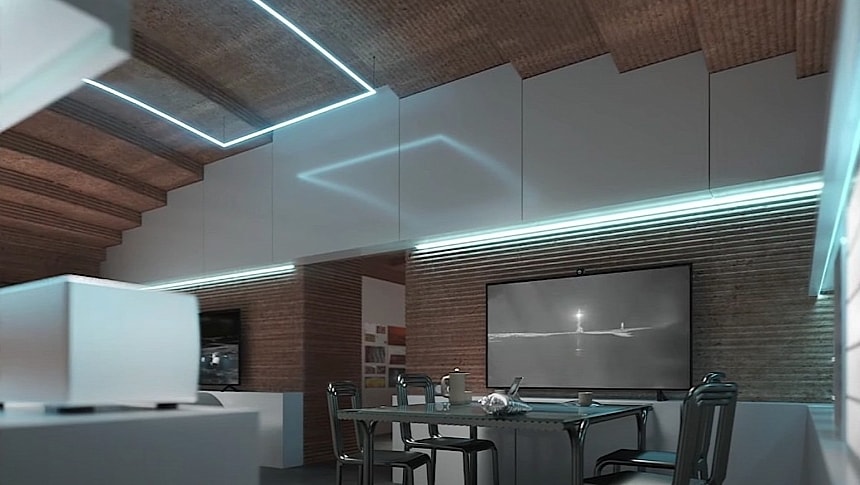The name CHAPEA might not mean all that much right now, but if NASA has its way the world's history books might very well record it as one of the first steps humanity has taken to reach planet Mars.
CHAPEA stands for Crew Health and Performance Exploration Analog, and it's technically an isolated habitat located at the Johnson Space Center in Houston, Texas. It's a place NASA announced not long ago as the ground zero for upcoming Martian crew experiments.
The facility is centered around a 1,700-square-foot (160 square meters) module that was 3D printed with help from a specialist Icon. The module is called Mars Dune Alpha and for the past 300+ days it has been home to a crew of four people, the first crew NASA sent on an imaginary year-long trip to Mars.
The four daring souls (all are volunteers) that have entered the isolated habitat on their own accord are Anca Selariu, Nathan Jones, Ross Brockwell, and Kelly Haston. They've been at it ever since June 25, 2023, meaning that on April 20 they celebrated their 300-day inside mark, a major step of accomplishing their goal of staying one year in there.
The Mars Dune Alpha stay was not a boring one, as the crew had to perform all sorts of tasks and missions. That's because NASA is not playing games with this, but intends to inform the upcoming real missions to the Red Planet.
During their stay, the four people had to perform a series of marswalks (simulated ones, of course), but more importantly than that, they had to grow and harvest some food on their own, in conditions similar to what people will encounter up there.
NASA does not share the exact scope of these agricultural experiments just yet, but it does say that the crops list grown in this secluded environment included salad, which was used to occasionally "supplement their shelf-stable food."
Because a stay on Mars would also require a lot of mechanical work, the crew had to perform various maintenance tasks. On top of it all, unexpected equipment failure was also practiced.
CHAPEA's crew number one is expected to complete its stay on July 6, 2024. NASA will continue to use the facility as it plans to send an additional two crews in these simulated, year-long missions to Mars.
Separately, the space agency is also running shorter-stay experiments in a facility called Human Exploration Research Analog (HERA). Also located at the Johnson Space Center, this 650 square feet (60 square meters) facility is meant to simulate the "isolation, confinement, and remote conditions in exploration scenarios."
A total of four distinct HERA missions are planned this year, with the second crew expected to enter the habitat on May 10 and stay there for the next 45 days. HERA is mostly used to conduct health studies.
The facility is centered around a 1,700-square-foot (160 square meters) module that was 3D printed with help from a specialist Icon. The module is called Mars Dune Alpha and for the past 300+ days it has been home to a crew of four people, the first crew NASA sent on an imaginary year-long trip to Mars.
The four daring souls (all are volunteers) that have entered the isolated habitat on their own accord are Anca Selariu, Nathan Jones, Ross Brockwell, and Kelly Haston. They've been at it ever since June 25, 2023, meaning that on April 20 they celebrated their 300-day inside mark, a major step of accomplishing their goal of staying one year in there.
The Mars Dune Alpha stay was not a boring one, as the crew had to perform all sorts of tasks and missions. That's because NASA is not playing games with this, but intends to inform the upcoming real missions to the Red Planet.
During their stay, the four people had to perform a series of marswalks (simulated ones, of course), but more importantly than that, they had to grow and harvest some food on their own, in conditions similar to what people will encounter up there.
NASA does not share the exact scope of these agricultural experiments just yet, but it does say that the crops list grown in this secluded environment included salad, which was used to occasionally "supplement their shelf-stable food."
Because a stay on Mars would also require a lot of mechanical work, the crew had to perform various maintenance tasks. On top of it all, unexpected equipment failure was also practiced.
CHAPEA's crew number one is expected to complete its stay on July 6, 2024. NASA will continue to use the facility as it plans to send an additional two crews in these simulated, year-long missions to Mars.
Separately, the space agency is also running shorter-stay experiments in a facility called Human Exploration Research Analog (HERA). Also located at the Johnson Space Center, this 650 square feet (60 square meters) facility is meant to simulate the "isolation, confinement, and remote conditions in exploration scenarios."
A total of four distinct HERA missions are planned this year, with the second crew expected to enter the habitat on May 10 and stay there for the next 45 days. HERA is mostly used to conduct health studies.







